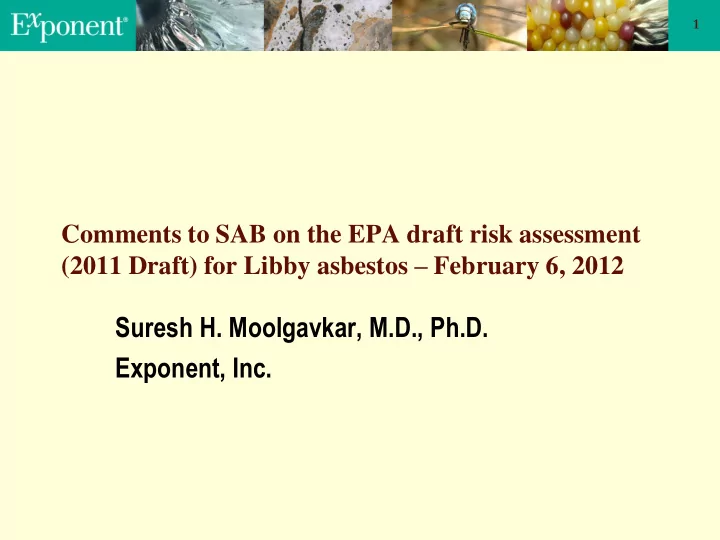

1 Comments to SAB on the EPA draft risk assessment (2011 Draft) for Libby asbestos – February 6, 2012 Suresh H. Moolgavkar, M.D., Ph.D. Exponent, Inc.
2 Inhalation Unit Risk (IUR) for Cancer IUR based on consideration of lung cancer and mesothelioma in the cohort of Grace workers at Libby. The latest follow-up of this cohort (through 2006) has 111 deaths from lung cancer and 19 deaths from mesothelioma (Larson et al., 2010). Earlier analyses (Moolgavkar et al., 2010; Sullivan, 2007) based on follow-up through 2002 with 95 lung cancer deaths and 15 mesothelioma deaths. 2011 Draft inappropriately bases risk assessment on the much smaller cohort of workers employed after 1959, with only 32 lung cancer deaths and 7 mesothelioma deaths. This choice of sub-cohort preferentially discards cancer deaths at the older ages when lung cancer and mesothelioma are most common.
3 Risk Assessment for Lung Cancer Based on a life-table analysis using the estimated RR from a Cox model analysis of the sub-cohort chosen by the Agency. 2011 Draft treats proportionality of hazards as a ‘law of nature’ and goes to great lengths (pages 5-76 – 5- 77) to explain why this ‘law’ is violated for lung cancer in the full Libby cohort. This is a principal reason given in the draft for choosing a sub-cohort for lung cancer risk assessment. 2011 Draft wrongly believes that proportionality holds in the sub-cohort. Failure to reject proportionality is probably a power issue (number of lung cancer cases reduced from 111 to 32). I find strong evidence of effect-modification by age (departures from proportionality of hazards) in the full Libby cohort. Particularly important to consider effect-modification when conducting life-table analyses. Sub- cohort chosen in the 2011 Draft is too small to detect departures from proportionality, particularly as these are non-monotonic.
4 Relative Risk (RR)
5 RR if proportionality holds From Richardson (2009). Analysis of lung cancer in South Carolina Textile Workers’ Cohort using TSCE (MVK) model.
6 From Richardson (2009). Analysis of lung cancer in South Carolina Textile Workers’ Cohort using Cox PH model.
7 Recommendations for lung cancer risk assessment 1. Use full Larson dataset (follow-up through 2006,111 lung cancers). 2. Explore effect modification by age. 3. Explore the use of biologically-based models, such as the multistage model and the two-stage clonal expansion (TSCE) model to incorporate entire time- varying exposure history into the analyses. 4. Use age-dependent RRs in life-table analyses.
8 Risk Assessment for Mesothelioma 2011 Draft uses the same truncated data set used for lung cancer risk assessment, discarding 12 of 19 mesotheliomas in the full data set. Completely ignores the importance of temporal factors in mesothelioma risk by using Poisson regression with cumulative exposure as the measure of exposure. Inappropriately jettisons the time-to-tumor analyses using the Peto- Nicholson model, which was the basis of the 1986 risk assessment, in favor of an ill-conceived Poisson regression. Claim of poor fit of the Peto-Nicholson model based on improper analysis of data.
9 Recommendations for Mesothelioma risk assessment 1. Use the entire Libby data (follow-up through 2006) used by Larson et al. (2010) with 19 cases of mesothelioma. 2. Use a likelihood-based time-to-tumor analysis with the Berman & Crump (2008) generalization of the Peto-Nicholson model. This generalization allows the use of time-dependent exposures. 3. Estimate both K M and the exponent in the model (see written comments). Other models, such as the TSCE model, could be tried as well. 4. Abandon the attempt to adjust for under-ascertainment of mesothelioma deaths in the Libby cohort for the reasons given in my written report. 5. Abandon the attempt to estimate the half-life of Libby asbestos in the pleura. The simple formulation used has no biological interpretation.
10 Risk Assessment for Non-Cancer End-Points Based on the Rohs et al. (2008) data. Localized pleural thickening taken as end- point of interest. 2011 Draft needs to provide better evidence that localized pleural thickening is an adverse health endpoint, rather than just a marker of asbestos exposure. Again, as is the case for cancer end-points, this EPA analysis discards most of the data from the Rohs data set and restricts analyses to workers hired after 1971 (80 cases among 280 participants reduced to 12 among 119 participants). The Agency fits numerous parametric models to the data with various lag structures, while failing to check whether a monotone increasing function of cumulative exposure is appropriate. Since the Rohs study reports on the prevalence of pleural abnormalities, the use of lags is totally inappropriate. There is NO information in the data on when the abnormality first appeared.
Exposure Response for Pleural Abnormalities in Rohs et al. (2008) data Response (beta for pleural abnormalities) 2 2 Non-statistically NOT significant dose- significant response relationship when age considered 1 1 ns(exp, 6) 0 0 -1 -1 Interstitial Fibrosis and Diffuse Pleural Thickening NOT statistically significant -2 -2 0 3 f/cc-yr 5 10 15 Cumulative Exposure exp 11
12 CONCLUSIONS AND RECOMMENDATIONS Risk assessments for both cancer and non-cancer end-points based on severely and inappropriately restricted data sets. Mesothelioma model is a giant step backwards because it ignores the important role played by pattern of exposure, rather than just cumulative exposure, in determining risk. Peto-Nicholson model should be more thoroughly explored. Lung cancer model should have been extended to examine the role of pattern of exposure, rather than just cumulative exposure. Proportionality of hazards is not a ‘law of nature’; nor does it have any intrinsic biological justification. Carcinogenic potency of Libby amphibole should be discussed in relation to carcinogenic potency of other asbestos fibers. Better justification for using localized pleural thickening as an adverse health endpoint should be given. The analysis of the Rohs data set is particularly simplistic. The use of lags for prevalent conditions is totally inappropriate. Detailed comments on these and other issues are provided in the written document.
Recommend
More recommend